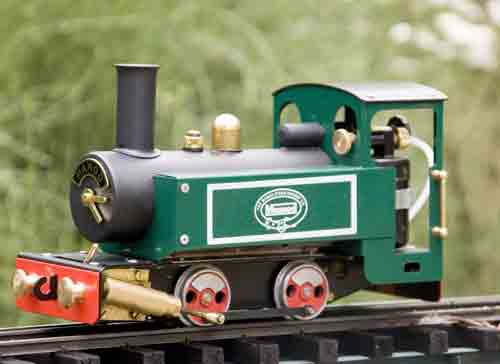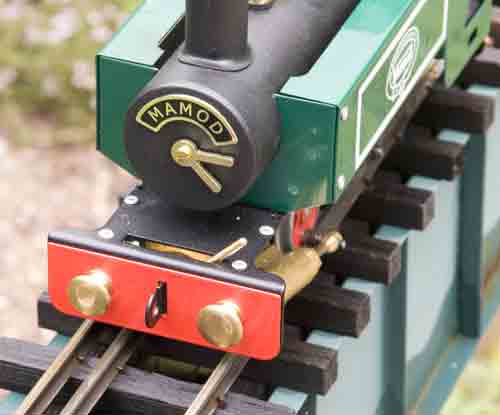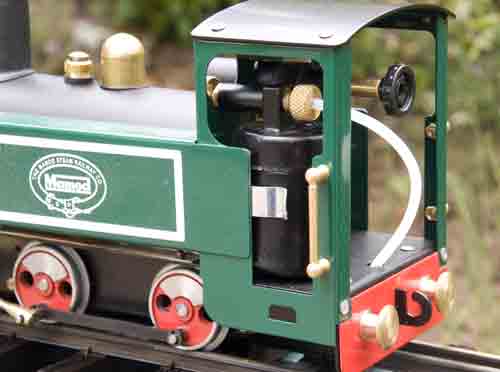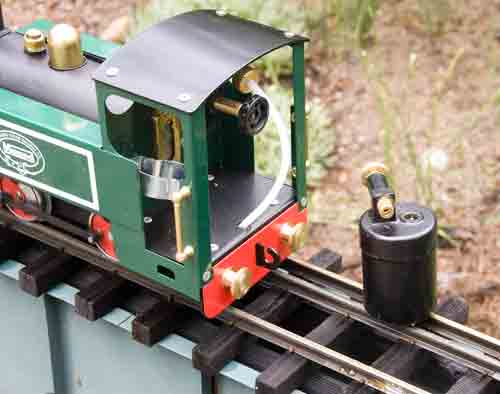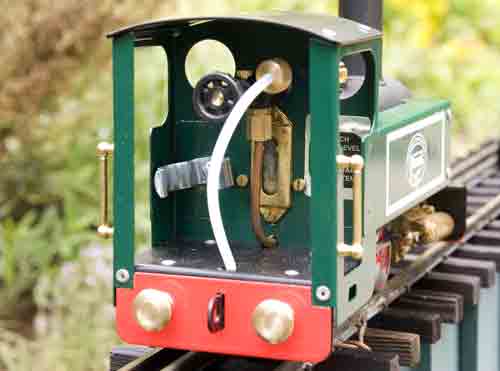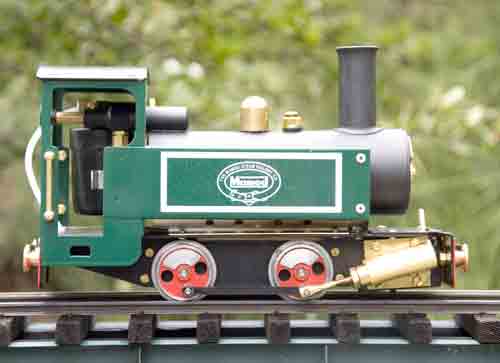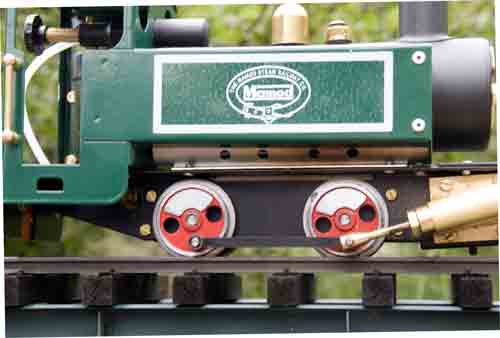Gauge 0, 1:19 scale, live-steam 0-4-0T
Mamod Steam Models
United Kingdom
Price £230, including shipping to the US (until November 2009)
Web site: www.mamod.co.uk
All metal, live-steam locomotive; ready to run; two, double-acting oscillating cylinders; gas fired; ceramic external burner; silver-soldered boiler; 40 psi blowoff pressure; safety valve, throttle, reversing lever, water glass; instructions and oil included; can be converted to gauge 1. Dimensions: length, 8½”; width, 3¼”; height, 5″. In 16mm (1:19) scale, this works out to 13’5″ x 5’2″ x 7’11”, respectively
Pros: Heavy, robust construction; quiet burner; higher blow-off pressure than original; efficient cylinders with glands; silver-soldered boiler; excellent finish; easy access to controls; strong runner
Cons: Filling gas tank is awkward; steam exhausts to ground, not out stack; R/C conversion would be difficult; no lubricator; difficult to run slowly; hard to see if fire is lit in bright sun; difficult to kitbash
Today, Mamod Steam Models, a descendant of the original company, has introduced a new and improved version of the original Mamod locomotive. This engine shares some of the features of the original, including a sight glass in the cab, a reversing lever on the pilot deck, a pair of double-acting oscillating cylinders, and riveted, sheet-metal body work. Beyond these superficial similarities, it is a completely different locomotive.
The new Mamod engine sports glands on the cylinders, significantly improving their efficiency. It has a larger, higher pressure, silver-soldered boiler with a pair of water tubes that extend into the fire space below to increase efficiency, and a safety valve that blows of at 40 psi, instead of the original’s 10 psi. This makes the locomotive a stronger puller. The lever at the front end controls direction only-there’s a proper throttle in the cab to control speed. Our review sample is 0 gauge; the company offers parts to easily convert the engine to gauge 1.
This locomotive is fired by an efficient ceramic burner, located beneath the boiler. A cylindrical gas tank resides in the cab, held in place by a clip. The instructions tell you to unscrew the fitting on the gas line and remove the line from the tank, before removing the tank from the engine to refill the gas. This is not nearly as convenient as filling most gas-fired engines, which have permanently mounted tanks. The gas line is made of stiff, whiteish plastic. It goes from the tank, through the cab floor, to the burner. Replacing the tank in the cab is a little awkward. I found that the easiest way was for the gas-control knob to protrude from the left-hand front window.
There is a throttle in the cab, controlled by a knob (a lever would be more convenient). The steam line descends from the throttle (partially obscuring the water glass), through the cab floor. From there it runs forward, through the fire (for some superheat), to the reversing lever, then to the cylinders. Sadly, steam is exhausted directly to the ground, not up the stack as on the original. The smoke stack is merely an ornament.
The right side of the cab is fairly roomy-enough so that you might be able to get some R/C gear in there. Controlling the throttle with a servo shouldn’t present too much of a problem but reversing the engine will. Not only is the reverser far away at the front of the engine, it is very stiff-possibly too stiff for a servo to actuate.
The engine is nicely finished in green and black, with red buffer beams and brass trim. However, the graphics are just unsightly plastic stickers, not even applied straight on one side of our review sample.
Aesthetics is a largely personal issue but I felt that they should be mentioned in this review. The original locomotive had the plausible look of a small, industrial locomotive. The new one looks much more like a toy. The drum shaped, non-functional smoke stack, the miniscule steam dome, and the throttle housing atop the boiler at the rear-not to mention the textured finish on the boiler-all contribute to this look.
Preparing the engine for a run is straightforward. The gas tank is removed, filled, and replaced, as mentioned above. The safety valve is removed and water is added to the boiler up to the maximum-fill point on the glass. The engine’s moving parts are lubricated, and it’s ready to go. This engine is not equipped with a cylinder lubricator. You pull the cylinders away from their port faces and add a drop or two of oil there, which is supposed to get into the cylinders to lubricate them. The original locomotive had no lubricator either. At its low operating pressure (and temperature), it relied on water in the cylinder for lubrication. Outside companies provided aftermarket lubricators for that engine, which worked to improve performance somewhat. This engine operates at a higher pressure and temperature and I think that a displacement lubricator, which would distribute proper steam oil to the cylinders, would be an asset and would increase the engine’s longevity.
To light the fire, I opened the gas valve a little until I heard a hissing sound (as per the instructions). The I applied a flame to the space between the boiler jacket and the frame. It caught immediately and I could see the blue glow of the fire atop the ceramic burner. The instructions say to let the engine warm up with the fire at its lowest setting for 30 seconds, at which time the valve can be opened a quarter turn. This I did. I prepared and lit the engine in my workshop. When I got outside into the bright light, I found it very difficult to see if the fire was lit.
The burner on this engine is nearly silent-a pleasant change from those on most internally gas-fired locomotives. Because of that, the noises of the engine are more clearly audible, which is nice. After around seven minutes the boiler pressure was high enough for the engine to run. I put it into forward gear and opened the throttle. Nothing much happened, so I gave it a push. Steam condensed into water in the cylinders, as is usual, and was expelled below the engine. After a few revolutions, the engine showed signs of life, and took off by itself.
At moderate to high speed, this engine is a strong runner. However, I could not get it to run slowly. At a certain point in the throttle’s travel, performance would get weak and the locomotive would just stop. However, if a train was tied on the back, that helped performance considerably. The throttle could be opened (for power) and the weight of the train could be used to control the speed a little better. Performance was equal in both directions.
The run lasted a little over 15 minutes, after pressure was up. At that point, the gas was exhausted; there was still some water in the boiler, which is how you want it. The engine ran strongly and continuously. It would no doubt have handled more than the 10 axles I put behind it. It’s a fun engine to run and watch trundling around the track.





